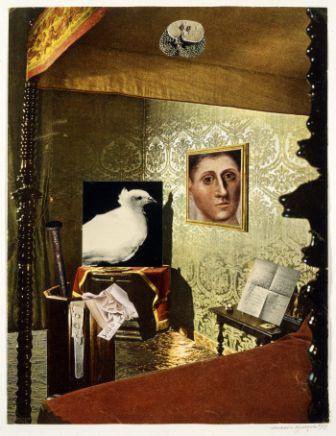Fernando de Azevedo
dal 18/4/2013 al 6/7/2013
Segnalato da
18/4/2013
Fernando de Azevedo
Calouste Gulbenkian Foundation Modern Art Centre CAM, Lisboa
The Unforeseen Reasons. Retrospective. From the vast work he created throughout six decades, this exhibition features paintings, occultations, collages, drawings, a sculpture, silkscreen paintings, illustrations, costume design, studies for stage sets and graphic work.

Curators: Leonor Nazaré
This retrospective is the first retrospective exhibition of Fernando de Azevedo (17.01.1922 / 28.08.2002).
Throughout his life, the artist held six individual exhibitions, in spite of his participation in numerous collective exhibitions. In 2004, the SNBA (in partnership with the Cerveira Biennale Museum and the Pontevedra Museum) held a tribute to the artist (exhibition and catalogue). In 2011, it displayed a small group of his works, in the context of an exhibition of artists about whom Fernando de Azevedo wrote. From the vast work he created throughout six decades, this exhibition features paintings, occultations, collages, drawings, a sculpture, silkscreen paintings, illustrations, costume design, studies for stage sets and graphic work.
The visual history of Surrealism is also uniquely marked by occultations (printed pages or drawings partially hidden by paint), whose origin can be probably found in Max Ernst’s overpaintings. The importance held by occultations in the transition into non-figuration in art and in the assumption of the importance of happenstance, of the unconscious and its unforeseen reasons must be noted. Azevedo’s occultations were dynamic and delicate, fluid and complex. The grotesque and the poetic, the vegetal or vaguely animal motif and the geometric force, the organic plasticity and the mechanical coexisted. The ghostlike aspect of the figures – sharp, rounded, in filaments, spongy, striated, lapidated, shaded – also appeared in the drawings that Azevedo also occulted in Indian ink, although a relative rigidity brought by the subjacent risks, conferred them greater weight, higher fixation, and, at times, a certain roughness.
Drawing (portrait, landscape, abstraction, surrealisation, illustration, graphic design), drawn notebooks, studies and annotations, and graphic design were a continuous activity for Azevedo.
In collages (which he developed mostly from the 1970s onwards), oneiric drift was a proclaimed and searched for constant, and maybe represents his most singular expression. The artist gathered paper cuttings, magazine pages and photographs, building an immense image bank, which he used with the necessary calm to pursue a thought out association and decision process – in general, he took his time.
His collages feature the fetishisation of the body, especially the female body; the suspension of gravity and of things; the diversity of the objects and of the world; iconographic and symbolic references to animals, flowers, fruit and elements (water, air, fire); allusions to vanitas and to the universes of history, art, and history of art, presented in successive mises en abîme.
Azevedo conferred particular strength on the shapes he isolated in close-up. The female nude became identified with the landscape, with the welcoming texture of fabrics, and the building walls, with taking over painting’s own place. Faces were always either expressionless or in a very close-up and partial, sometimes androgynous and hieratic, sometimes transforming a rigid appearance into a clairvoyant, unfathomable character. Draperies and curtains share a double condition, as scenography and eroticism. They frequently fulfil the creation of an enigma, in which discrete (latent) violence can be read. Images of frontispieces, doors, monuments, stages and buildings generated the monumentality favourable to the surprise caused by details suddenly incrusted in them, or by the images of indoor spaces: furniture, bibelots, chairs, bath tubs, floors. Music scores, books, tripods and easels introduced references to erudition and art in the visual amalgamate of the collages.
The recurrence of frames, doors and windows, mirrors and screens is central and structuring. They were some of the most important compositional devices, or traps, in which he “captured his monsters”, fantasies and references. “Nowadays, painters know that external and internal reality have two identities originating from the same common line” – wrote Fernando de Azevedo in 1951 (“Situação de pintura”, Lisbon, in Unicórnio, 1951).
This brief sentence combines the essence of the Surrealist programme and the personal quest of Fernando de Azevedo. If internal reality is more real that the banal external reality, the truth of both is forcibly determined by the commitment of the artists to their (re)configurations. The motivations of the unconscious are unforeseen but real – they erupt into the urgency of expression with the strangeness and strength that freedom confers upon them.
Centro de Arte Moderna
Rua Dr. Nicolau de Bettencourt 1050-078 Lisboa
Hours:
Tuesday to Sunday 10:00 to 18:00
Last admission at the museum at 17:45
Closed on Mondays and on December 25th, January 1st, Easter Sunday and May 1.
Adults: 5,00 €
FREE ADMISSION Sundays; Children under 12



